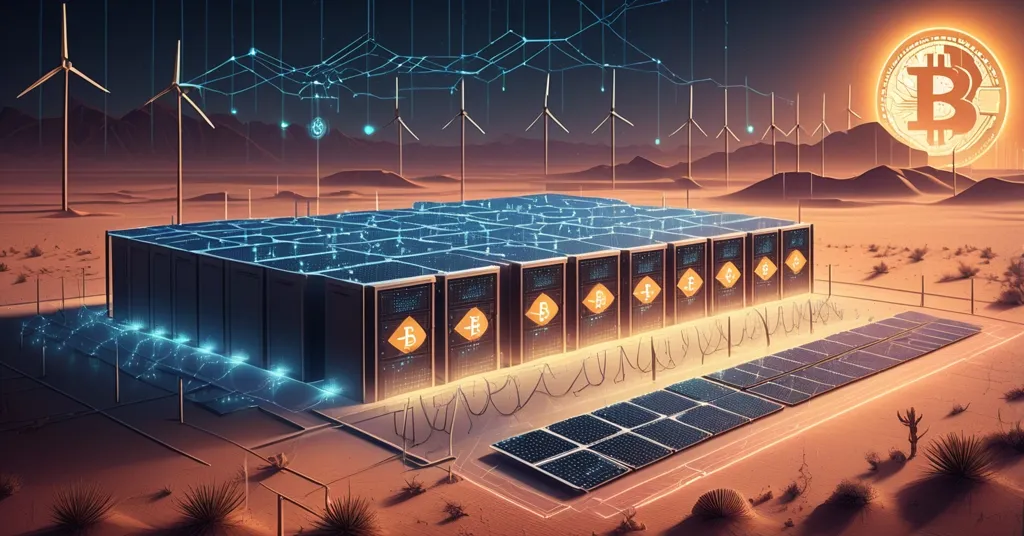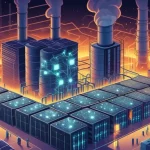US Power Crisis Threatens Bitcoin Mining and AI Growth in Data Center Bottleneck

US Power Shortages Threaten Bitcoin Mining and AI Growth in Data Center Crisis
Power shortages across the US are grinding tech innovation to a screeching halt, with data center developers like Digital Realty Trust Inc. and Stack Infrastructure stuck waiting for electricity in Santa Clara, California. This isn’t just a Silicon Valley snag—it’s a full-blown warning for energy-hungry sectors like Bitcoin mining and blockchain infrastructure, where every lost watt could mean millions in missed opportunities.
- Grid Lockdown: Data center projects in Santa Clara face delays of years due to insufficient power supply.
- AI and Crypto Strain: Electricity demand for AI could double by 2035, while crypto mining adds fuel to the fire.
- Energy Bottleneck: Aging US grids and regulatory lag threaten the future of decentralized tech.
Santa Clara’s Power Crisis: A Tech Hub in Limbo
Santa Clara, often seen as the beating heart of tech innovation with 57 data centers either operational or under construction, is grappling with a crisis that could ripple far beyond its borders. Digital Realty Trust Inc., a major player in data center real estate, applied to build a facility there back in 2019—yet, half a decade later, it’s still not fully powered up. Stack Infrastructure, recently acquired by Blue Owl Capital Inc., faces a similar fate with its 48-megawatt project sitting idle, unable to flick the switch. The root cause? A local power grid that’s wheezing under pressure. Silicon Valley Power (SVP), the city-owned utility, is pouring $450 million into a system upgrade to meet the skyrocketing demand, but the finish line isn’t until 2028. That’s a lifetime in tech years.
“SVP is working on a $450 million upgrade to their system to meet the needs of these customers and others. This project is on track to finish by 2028,” said Janine de la Vega, spokesperson for Silicon Valley Power.
The demand for data centers is off the charts, driven by the explosive growth of cloud computing and artificial intelligence (AI). These facilities aren’t just buildings full of computers—they’re power-hungry beasts, running thousands of servers 24/7, with cooling systems to prevent meltdowns and backup generators for emergencies. BloombergNEF forecasts that electricity needs for AI computing alone could double by 2035, equivalent to powering millions of additional homes. Industry titans like Sam Altman of OpenAI and Jensen Huang of Nvidia are betting big, predicting trillions of dollars in investments for AI infrastructure over the coming decades. But here’s the harsh reality: all the cash in the world can’t generate electricity if the grid is a relic of the analog age.
“The demand has reached an all-time high, and we are facing a power-supply issue,” warned Bill Dougherty, Executive Vice President for Data Center Solutions at CBRE Group Inc.
Energy Deficit Hits Nationwide: Not Just a Silicon Valley Problem
Don’t think this is just Santa Clara’s headache. Power constraints are strangling tech growth across the US, from northern Virginia’s Data Center Alley—home to the world’s largest concentration of computing facilities—to states like New Mexico, Louisiana, Texas, and Pennsylvania. Dominion Energy Inc. in northern Virginia estimates that connecting large data centers to the grid could take anywhere from one to seven years. Even a juggernaut like Amazon is getting burned, filing a complaint against a Berkshire Hathaway-owned utility in Oregon for failing to deliver enough power to four of its data centers. If a trillion-dollar company can’t get the lights on, what chance do smaller outfits have?
The core issue is a toxic mix of outdated infrastructure, snail-paced development of new transmission lines, and regulatory red tape that moves slower than a dial-up connection in the 90s. The US power grid was built for a different era, not for the digital revolution, let alone the energy demands of AI or cryptocurrency mining. Agencies like the Federal Energy Regulatory Commission (FERC) often drag their feet on approvals for grid upgrades, while local utilities struggle to balance residential needs with the insatiable appetite of tech. This isn’t just a logistical hiccup—it’s a fundamental threat to the scalability of technologies that define disruption and decentralization.
Crypto Caught in the Crossfire: Bitcoin Mining and Blockchain at Risk
So where does this leave the crypto and blockchain space? For those new to the game, blockchain is the decentralized ledger tech behind cryptocurrencies like Bitcoin—a system that cuts out middlemen like banks, ensuring transparency and security through a network of computers. Bitcoin mining, the process of validating transactions by solving complex math problems, is a power hog. A single large-scale mining operation can consume as much electricity as a small town, often relying on the same data center infrastructure now hitting a brick wall. According to the Cambridge Bitcoin Electricity Consumption Index (CBECI), Bitcoin mining globally uses more power than some mid-sized nations, like Argentina. Throw in AI’s doubling demand by 2035, and you’ve got a grid on life support.
Bitcoin maximalists—those who see BTC as the ultimate form of money—might argue this crisis is a rallying cry for the industry to lead on energy innovation. The ethos of decentralization isn’t just about dodging centralized finance; it’s about self-reliance. Think solar-powered mining rigs in the desert or off-grid setups in remote areas. There’s precedent—miners in Quebec have tapped into cheap hydropower, while some Texas operations partner with wind farms to balance costs and sustainability. But let’s not sugarcoat it: scaling renewable energy for crypto mining takes time, capital, and political will, none of which are abundant when utilities are already stretched thin.
Altcoins and other blockchain protocols have their own skin in the game. Ethereum, for instance, made headlines with its 2022 “Merge,” shifting to a proof-of-stake (PoS) model—a less energy-intensive way to validate transactions compared to Bitcoin’s proof-of-work (PoW), which demands massive computational muscle. Reports suggest Ethereum’s energy use dropped by over 99.9% post-merge. That’s a win, but it’s not a full escape. Ethereum still relies on data centers for hosting nodes and running decentralized applications (dApps)—apps built on blockchain networks without a central authority. Smaller chains like Solana or Cardano face similar dependencies. No one’s truly insulated from the energy bottleneck.
Could This Be a Reality Check for Crypto and AI?
Let’s play devil’s advocate for a moment. Could these power shortages be the slap in the face that tech needs? Bitcoin mining has long been slammed for its environmental footprint, with critics pointing out that its carbon emissions rival those of small countries. AI isn’t innocent either—training a single large language model can emit as much CO2 as a transatlantic flight for dozens of people. Maybe grid failures force both industries to rethink priorities, cutting back on speculative mining booms or AI projects with dubious real-world value. Environmentalists might cheer for a slowdown, arguing it buys time for sustainable solutions to catch up.
But let’s not get too comfortable with that narrative. Stifling innovation because of infrastructure failures isn’t progress—it’s a cop-out. Centralized systems, from legacy banking to Big Tech monopolies, aren’t slowing down; they’re doubling down. If Bitcoin and blockchain are to deliver on their promise of financial freedom, or if AI is to redefine industries, we can’t afford to hit pause. This is where effective accelerationism—pushing hard and fast for progress—comes into play. We need to bulldoze through these bottlenecks, not just with grid upgrades but by rethinking energy itself. Nuclear micro-reactors, small modular power plants that could sit next to data centers delivering clean, consistent power, are already being piloted in some tech circles. Decentralized energy grids, mirroring the ethos of blockchain, could distribute power without relying on creaky centralized utilities. The solutions exist; the urgency does too.
Solutions on the Horizon: Decentralized Energy for a Decentralized Future?
Zooming out, this energy crisis isn’t just a tech problem—it’s a societal one. Data centers underpin everything from autonomous vehicles to high-frequency crypto trading algorithms, sectors as critical to the economy as they are power-thirsty. For blockchain, often painted as an energy villain (sometimes deservedly so), there’s a PR battle layered on top of the practical one. Yet, if we’re serious about disrupting the status quo—whether through Bitcoin’s monetary rebellion or AI’s transformative potential—we need to act now. Waiting until 2028 for upgrades like Silicon Valley Power’s isn’t an option. Crypto innovators, in particular, have a chance to lead here, piloting off-grid solutions or advocating for policies that fast-track renewable integration.
Take Texas, where Bitcoin miners faced mass shutdowns during the 2021 grid collapse. Some adapted by striking deals with energy providers to curb usage during peak demand, earning credits in return—a model that could scale. Or look at El Salvador, where pro-Bitcoin policies include plans to power mining with volcanic geothermal energy. These aren’t just stopgaps; they’re blueprints for a future where decentralized tech drives decentralized energy. The trillion-dollar investments forecasted for AI infrastructure could spill over into crypto if the community plays its cards right, proving that freedom from centralized systems extends to the very power that fuels them.
Key Takeaways and Questions to Ponder
- What’s behind the power shortages stalling data centers in Santa Clara?
Aging grids, slow transmission line builds, and regulatory delays are crippling projects by Digital Realty Trust and Stack Infrastructure, leaving them powerless for years. - How do energy bottlenecks impact Bitcoin mining and blockchain scalability?
Mining operations guzzle electricity, often via data centers, so shortages spike costs and limit growth, while blockchain networks struggle to maintain nodes and dApps without reliable power. - Is there a potential upside for decentralization in this crisis?
Absolutely—constraints could force crypto to pioneer sustainable energy like solar or geothermal mining, embodying the self-reliance at the core of decentralization. - Are US power grid issues a unique barrier to tech growth?
Not entirely, but the US’s outdated infrastructure and bureaucratic lag stand out, especially in tech hubs like Santa Clara and northern Virginia’s Data Center Alley. - What’s the timeline for fixes, and can crypto afford the wait?
Upgrades like SVP’s $450 million project won’t wrap until 2028—a delay that might push crypto innovators toward off-grid or alternative energy solutions sooner rather than later.
The bottom line is stark: power shortages are the Achilles’ heel of technological disruption. For Bitcoin to cement its role as the future of money, for blockchain to scale as a cornerstone of freedom, and for AI to reshape our world, the US must overhaul its energy game—yesterday. Trillions in investment are waiting, but money doesn’t generate volts. This is a wake-up call for the crypto community to not just innovate in code, but in kilowatts. If we’re truly about accelerating progress, we can’t let something as basic as a power cord trip us up. Will we seize this crisis to lead, or let grid failures stall the revolution we’ve fought so hard for?



